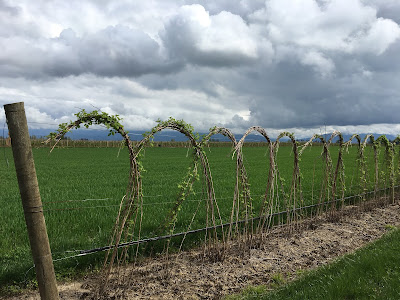Farming Friday -- April 26, 2019
It’s the time of the year where I try not to look out at the
field. When the leaves start coming out on the berries, they develop at such
varied rates. One bush will be mostly green and the next, buds just starting to
push out, canes mostly brown. In the early years, I would be pretty nervous
that half of the bushes were dead, and we were going to have a very bad year. But
then by May they would have caught up to each other and the field would be a
beautiful uniformly arced green, at its prettiest.
Overlooking the field, you can see the variation in leaf development, and the areas where winter damage is greater.
This year, we know there are a lot of dead canes, and we are
going to be seeing many more brown canes than we’d like. We have a cooler
spring after the late winter, and all the growth is delayed. As the leaves started
coming out, the cane mortality seemed very high – but we have been surprised to
continue to see buds start to push out on canes we might have written off. It’s
quite heartening! And a little shocking that canes in the same bundle might
come to life at such varied times.
This row is well-leafed...
...while the row next to it is much farther behind.
Winter damage is so unpredictable! Right now we are grateful
to see less mortality than expected. It remains to be seen if these little
buds, still pushing out, will have the vigor to come to fruit. At least we are
seeing the possibility!
This little bud is on the brown canes below, on the left.
The bush to the right is well-leafed.
Work continues in the 10 acres of planting that was cut
down. Randy is rolling out wire down each row, and the workers are stapling it
to the posts. Then the buried irrigation drip tape is pulled up out of the ground
and hung on the wire. Green is beginning to show where the plants were cut off.
They will need the irrigation as they regrow this year.
Another chore for this time of year is cane-burning. We don’t
use fire, but an herbicide that desiccates the raspberry primocanes that have
started growing. As you recall, our Meeker variety of raspberries grows primocanes
one year, and those become the fruiting (floricanes) the second year. If we did not burn back the primocanes, they
would be so big as to interfere with harvesting the fruit on the floricanes.
Also, they could become way too long for tying to our trellis. They could
possible double back down to the ground. Besides the difficulty of managing
that much cane, it is a problem for managing that much foliage in the floricane
year. The canopy gets so dense that air movement is hindered, making the fruit
more vulnerable to mold.
Cane-burning is a fussy operation as you want to avoid burning
too high on the canes, or burning too early and having too much growth. We’re
always glad when its time to just let them grow unhindered!
Fertlizer has been spread, both organic and commercial, on
the berries, and the grass roadways. Soon it will be time to start prepping the
ground for planting. Always much to do, and we are enjoying the glorious sunny
days full of spring work. We have to keep at it because you can also see that little bitty flower buds are showing up on those canes too! Harvest will be here before we know it!
Center...a clump of tiny flower buds...future raspberries...God willing and the creek don't rise!








Comments